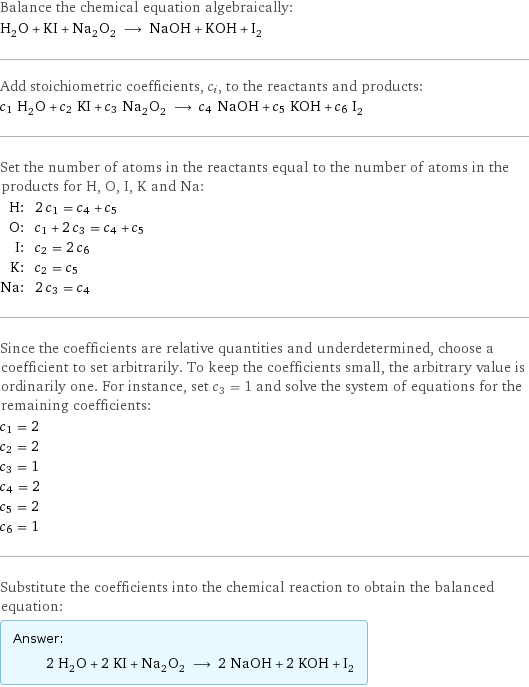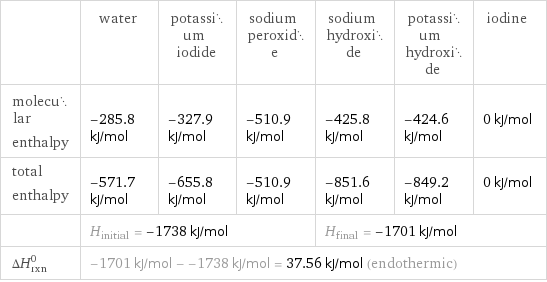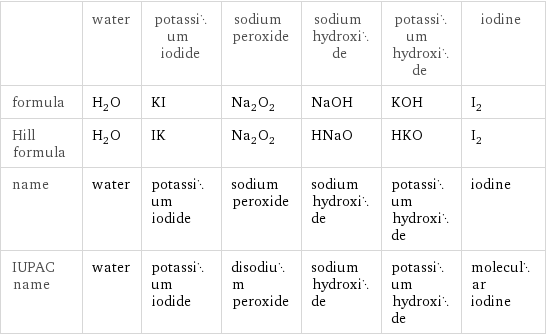Input interpretation

H_2O water + KI potassium iodide + Na_2O_2 sodium peroxide ⟶ NaOH sodium hydroxide + KOH potassium hydroxide + I_2 iodine
Balanced equation

Balance the chemical equation algebraically: H_2O + KI + Na_2O_2 ⟶ NaOH + KOH + I_2 Add stoichiometric coefficients, c_i, to the reactants and products: c_1 H_2O + c_2 KI + c_3 Na_2O_2 ⟶ c_4 NaOH + c_5 KOH + c_6 I_2 Set the number of atoms in the reactants equal to the number of atoms in the products for H, O, I, K and Na: H: | 2 c_1 = c_4 + c_5 O: | c_1 + 2 c_3 = c_4 + c_5 I: | c_2 = 2 c_6 K: | c_2 = c_5 Na: | 2 c_3 = c_4 Since the coefficients are relative quantities and underdetermined, choose a coefficient to set arbitrarily. To keep the coefficients small, the arbitrary value is ordinarily one. For instance, set c_3 = 1 and solve the system of equations for the remaining coefficients: c_1 = 2 c_2 = 2 c_3 = 1 c_4 = 2 c_5 = 2 c_6 = 1 Substitute the coefficients into the chemical reaction to obtain the balanced equation: Answer: | | 2 H_2O + 2 KI + Na_2O_2 ⟶ 2 NaOH + 2 KOH + I_2
Structures

+ + ⟶ + +
Names

water + potassium iodide + sodium peroxide ⟶ sodium hydroxide + potassium hydroxide + iodine
Reaction thermodynamics
Enthalpy

| water | potassium iodide | sodium peroxide | sodium hydroxide | potassium hydroxide | iodine molecular enthalpy | -285.8 kJ/mol | -327.9 kJ/mol | -510.9 kJ/mol | -425.8 kJ/mol | -424.6 kJ/mol | 0 kJ/mol total enthalpy | -571.7 kJ/mol | -655.8 kJ/mol | -510.9 kJ/mol | -851.6 kJ/mol | -849.2 kJ/mol | 0 kJ/mol | H_initial = -1738 kJ/mol | | | H_final = -1701 kJ/mol | | ΔH_rxn^0 | -1701 kJ/mol - -1738 kJ/mol = 37.56 kJ/mol (endothermic) | | | | |
Gibbs free energy

| water | potassium iodide | sodium peroxide | sodium hydroxide | potassium hydroxide | iodine molecular free energy | -237.1 kJ/mol | -324.9 kJ/mol | -447.7 kJ/mol | -379.7 kJ/mol | -379.4 kJ/mol | 0 kJ/mol total free energy | -474.2 kJ/mol | -649.8 kJ/mol | -447.7 kJ/mol | -759.4 kJ/mol | -758.8 kJ/mol | 0 kJ/mol | G_initial = -1572 kJ/mol | | | G_final = -1518 kJ/mol | | ΔG_rxn^0 | -1518 kJ/mol - -1572 kJ/mol = 53.5 kJ/mol (endergonic) | | | | |
Equilibrium constant
![Construct the equilibrium constant, K, expression for: H_2O + KI + Na_2O_2 ⟶ NaOH + KOH + I_2 Plan: • Balance the chemical equation. • Determine the stoichiometric numbers. • Assemble the activity expression for each chemical species. • Use the activity expressions to build the equilibrium constant expression. Write the balanced chemical equation: 2 H_2O + 2 KI + Na_2O_2 ⟶ 2 NaOH + 2 KOH + I_2 Assign stoichiometric numbers, ν_i, using the stoichiometric coefficients, c_i, from the balanced chemical equation in the following manner: ν_i = -c_i for reactants and ν_i = c_i for products: chemical species | c_i | ν_i H_2O | 2 | -2 KI | 2 | -2 Na_2O_2 | 1 | -1 NaOH | 2 | 2 KOH | 2 | 2 I_2 | 1 | 1 Assemble the activity expressions accounting for the state of matter and ν_i: chemical species | c_i | ν_i | activity expression H_2O | 2 | -2 | ([H2O])^(-2) KI | 2 | -2 | ([KI])^(-2) Na_2O_2 | 1 | -1 | ([Na2O2])^(-1) NaOH | 2 | 2 | ([NaOH])^2 KOH | 2 | 2 | ([KOH])^2 I_2 | 1 | 1 | [I2] The equilibrium constant symbol in the concentration basis is: K_c Mulitply the activity expressions to arrive at the K_c expression: Answer: | | K_c = ([H2O])^(-2) ([KI])^(-2) ([Na2O2])^(-1) ([NaOH])^2 ([KOH])^2 [I2] = (([NaOH])^2 ([KOH])^2 [I2])/(([H2O])^2 ([KI])^2 [Na2O2])](../image_source/6e2a01e718a2baa9ab4311d44f5ff461.png)
Construct the equilibrium constant, K, expression for: H_2O + KI + Na_2O_2 ⟶ NaOH + KOH + I_2 Plan: • Balance the chemical equation. • Determine the stoichiometric numbers. • Assemble the activity expression for each chemical species. • Use the activity expressions to build the equilibrium constant expression. Write the balanced chemical equation: 2 H_2O + 2 KI + Na_2O_2 ⟶ 2 NaOH + 2 KOH + I_2 Assign stoichiometric numbers, ν_i, using the stoichiometric coefficients, c_i, from the balanced chemical equation in the following manner: ν_i = -c_i for reactants and ν_i = c_i for products: chemical species | c_i | ν_i H_2O | 2 | -2 KI | 2 | -2 Na_2O_2 | 1 | -1 NaOH | 2 | 2 KOH | 2 | 2 I_2 | 1 | 1 Assemble the activity expressions accounting for the state of matter and ν_i: chemical species | c_i | ν_i | activity expression H_2O | 2 | -2 | ([H2O])^(-2) KI | 2 | -2 | ([KI])^(-2) Na_2O_2 | 1 | -1 | ([Na2O2])^(-1) NaOH | 2 | 2 | ([NaOH])^2 KOH | 2 | 2 | ([KOH])^2 I_2 | 1 | 1 | [I2] The equilibrium constant symbol in the concentration basis is: K_c Mulitply the activity expressions to arrive at the K_c expression: Answer: | | K_c = ([H2O])^(-2) ([KI])^(-2) ([Na2O2])^(-1) ([NaOH])^2 ([KOH])^2 [I2] = (([NaOH])^2 ([KOH])^2 [I2])/(([H2O])^2 ([KI])^2 [Na2O2])
Rate of reaction
![Construct the rate of reaction expression for: H_2O + KI + Na_2O_2 ⟶ NaOH + KOH + I_2 Plan: • Balance the chemical equation. • Determine the stoichiometric numbers. • Assemble the rate term for each chemical species. • Write the rate of reaction expression. Write the balanced chemical equation: 2 H_2O + 2 KI + Na_2O_2 ⟶ 2 NaOH + 2 KOH + I_2 Assign stoichiometric numbers, ν_i, using the stoichiometric coefficients, c_i, from the balanced chemical equation in the following manner: ν_i = -c_i for reactants and ν_i = c_i for products: chemical species | c_i | ν_i H_2O | 2 | -2 KI | 2 | -2 Na_2O_2 | 1 | -1 NaOH | 2 | 2 KOH | 2 | 2 I_2 | 1 | 1 The rate term for each chemical species, B_i, is 1/ν_i(Δ[B_i])/(Δt) where [B_i] is the amount concentration and t is time: chemical species | c_i | ν_i | rate term H_2O | 2 | -2 | -1/2 (Δ[H2O])/(Δt) KI | 2 | -2 | -1/2 (Δ[KI])/(Δt) Na_2O_2 | 1 | -1 | -(Δ[Na2O2])/(Δt) NaOH | 2 | 2 | 1/2 (Δ[NaOH])/(Δt) KOH | 2 | 2 | 1/2 (Δ[KOH])/(Δt) I_2 | 1 | 1 | (Δ[I2])/(Δt) (for infinitesimal rate of change, replace Δ with d) Set the rate terms equal to each other to arrive at the rate expression: Answer: | | rate = -1/2 (Δ[H2O])/(Δt) = -1/2 (Δ[KI])/(Δt) = -(Δ[Na2O2])/(Δt) = 1/2 (Δ[NaOH])/(Δt) = 1/2 (Δ[KOH])/(Δt) = (Δ[I2])/(Δt) (assuming constant volume and no accumulation of intermediates or side products)](../image_source/402147fba180beabfdc13ef05c7ee22f.png)
Construct the rate of reaction expression for: H_2O + KI + Na_2O_2 ⟶ NaOH + KOH + I_2 Plan: • Balance the chemical equation. • Determine the stoichiometric numbers. • Assemble the rate term for each chemical species. • Write the rate of reaction expression. Write the balanced chemical equation: 2 H_2O + 2 KI + Na_2O_2 ⟶ 2 NaOH + 2 KOH + I_2 Assign stoichiometric numbers, ν_i, using the stoichiometric coefficients, c_i, from the balanced chemical equation in the following manner: ν_i = -c_i for reactants and ν_i = c_i for products: chemical species | c_i | ν_i H_2O | 2 | -2 KI | 2 | -2 Na_2O_2 | 1 | -1 NaOH | 2 | 2 KOH | 2 | 2 I_2 | 1 | 1 The rate term for each chemical species, B_i, is 1/ν_i(Δ[B_i])/(Δt) where [B_i] is the amount concentration and t is time: chemical species | c_i | ν_i | rate term H_2O | 2 | -2 | -1/2 (Δ[H2O])/(Δt) KI | 2 | -2 | -1/2 (Δ[KI])/(Δt) Na_2O_2 | 1 | -1 | -(Δ[Na2O2])/(Δt) NaOH | 2 | 2 | 1/2 (Δ[NaOH])/(Δt) KOH | 2 | 2 | 1/2 (Δ[KOH])/(Δt) I_2 | 1 | 1 | (Δ[I2])/(Δt) (for infinitesimal rate of change, replace Δ with d) Set the rate terms equal to each other to arrive at the rate expression: Answer: | | rate = -1/2 (Δ[H2O])/(Δt) = -1/2 (Δ[KI])/(Δt) = -(Δ[Na2O2])/(Δt) = 1/2 (Δ[NaOH])/(Δt) = 1/2 (Δ[KOH])/(Δt) = (Δ[I2])/(Δt) (assuming constant volume and no accumulation of intermediates or side products)
Chemical names and formulas

| water | potassium iodide | sodium peroxide | sodium hydroxide | potassium hydroxide | iodine formula | H_2O | KI | Na_2O_2 | NaOH | KOH | I_2 Hill formula | H_2O | IK | Na_2O_2 | HNaO | HKO | I_2 name | water | potassium iodide | sodium peroxide | sodium hydroxide | potassium hydroxide | iodine IUPAC name | water | potassium iodide | disodium peroxide | sodium hydroxide | potassium hydroxide | molecular iodine
Substance properties

| water | potassium iodide | sodium peroxide | sodium hydroxide | potassium hydroxide | iodine molar mass | 18.015 g/mol | 166.0028 g/mol | 77.978 g/mol | 39.997 g/mol | 56.105 g/mol | 253.80894 g/mol phase | liquid (at STP) | solid (at STP) | solid (at STP) | solid (at STP) | solid (at STP) | solid (at STP) melting point | 0 °C | 681 °C | 660 °C | 323 °C | 406 °C | 113 °C boiling point | 99.9839 °C | 1330 °C | | 1390 °C | 1327 °C | 184 °C density | 1 g/cm^3 | 3.123 g/cm^3 | 2.805 g/cm^3 | 2.13 g/cm^3 | 2.044 g/cm^3 | 4.94 g/cm^3 solubility in water | | | reacts | soluble | soluble | surface tension | 0.0728 N/m | | | 0.07435 N/m | | dynamic viscosity | 8.9×10^-4 Pa s (at 25 °C) | 0.0010227 Pa s (at 732.9 °C) | | 0.004 Pa s (at 350 °C) | 0.001 Pa s (at 550 °C) | 0.00227 Pa s (at 116 °C) odor | odorless | | | | |
Units
